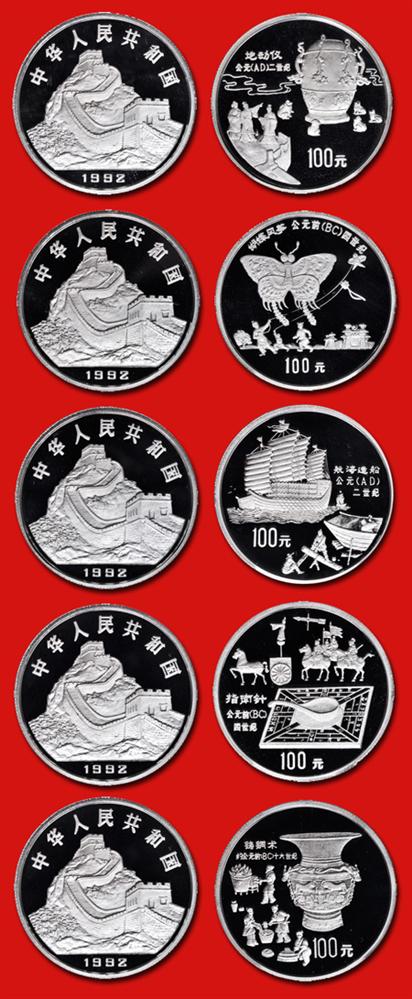
China’s continuous history stretches back for a total of nearly 5,000 years, and in this span of five millennia, the list of discoveries and inventions is almost limitless. With the help of “The Genius of China – 3000 Years of Science, Discovery and Invention” by Dr. Robert Temple, several significant subjects were chosen. For the inaugural set five coin designs were chosen and were struck in silver, gold, and platinum. This set being offered for this auction is the very rare platinum set of one ounce pieces. Each coin in this set shares the same reverse design, which includes the upper Chinese inscription stating: “People’s Republic of China”, and below the design the date of issue, 1992. Between the legends is a breathtaking view of China’s iconic Great Wall, as it winds up a mountainous peak. Built during the Qin Dynasty in the late third century B.C. and extensively rebuilt and modified during the Ming Dynasty (14th to 17th Century A.D.) the Great Wall served as a bulwark against the northern Mongol tribes and as a tool to control trade. The Great Wall of China has since become an international symbol of power and one of China’s greatest achievements.
China’s many significant scientific innovations and developments are expertly displayed throughout the various Invention and Discoveries sets, and this introductory set from 1992 is an excellent example. The five designs in this set showcase: an ancient seismograph, the first kite, navigation and shipbuilding, the compass, and Bronze Age art and metalworking. The first coin represents the seismograph invented by Zhang Heng, a first century A.D. Eastern Han Dynasty polymath (scholar, poet, inventor and scientist). This device could determine the direction of the epicenter of an earthquake up to 300 miles away. The design shows a massive urn like device in the upper right side, with elaborate dragon flange pieces. To the left of the urn is a Chinese inscription stating “Seismograph 2nd Century A.D.” Below the inscription are three Chinese scholars in a discussion, and to the right the denomination of 100 Yuan is shown. The next coin depicts the invention of the kite in the 4th Century B.C. by the philosopher Mozi. A descriptive Chinese inscription, which reads “Kite 4th Century B.C.,” adorns the upper rim of the coin. Below, a large butterfly kite is shown, with amazing detail present in its wing design. Three children playing with kites are shown below, with a building off in the distance and the denomination of 100 Yuan shown at the bottom.
The next coin proudly displays the innovations made by the Chinese in the fields of shipbuilding and navigation. The usual Chinese inscription describes the discovery and the approximate dates, this one being the 2nd Century A.D. A huge Junk style boat is shown with an enormous hull, 11 oars (visible only on one side, so the junk had a total of 22), two levels of decks, and four masts with “battened sails” (long horizontal stabilizing poles in the sails, giving it a rippled effect). A second boat of a more or less European design is shown in the distance, and is dwarfed by the Chinese vessel due to distance. Directly below the ship is the denomination of 100 Yuan, and a scene to the right, which displays shipbuilding methods. The fourth coin showcases China’s invention of a compass device in the 4th Century B.C., during the Warring States Period. During this time Chinese scholars discovered that certain rocks – lodestones – had magnetic properties and when they were suspended in water they would rotate and align south. This tool provided an enormous advantage in naval navigation, travelling, and the marching of troops. The image on the coin shows a troop of soldiers marching underneath a compass arrow. Below, a picture of the compass device is shown, it appears as a metal plate lined with symbols and characters with a spoon like item in the center. To the left appears the Chinese legend: “Compass 4th Century B.C.” and at the bottom of the design appears the denomination of 100 Yuan. The final piece of this series features the oldest invention and innovation: “Bronze Age art and metal working.” A large ornate urn dominates the field, with dragons and other elaborate designs, and to the upper left appears a Chinese inscription stating the subject and date range of approximately 16th Century B.C. Three scenes show the various stages of production including what appears to be a forge and blacksmith, an anvil with two metal smiths, and an artist painting or engraving the final piece. This highly collectable set is further enhanced by the stellar grade of PCGS Proof 69 Deep Cameo, which all five pieces hold. Rarity also comes into play, as each coin has a mintage of only 100 pieces. This set is elusive and ranks high on the list of sought after proof sets.
Look for this and other Asian numismatic rarities in our upcoming August Hong Kong Sale. Preview this impressive coin along with the rest of our auction this August at the Stack’s Bowers and Ponterio office located in Irvine, California. For details please refer to the Auction Schedule/Details link under Current Auctions at www.StacksBowers.com. To schedule an appointment, please call 800.566.2580. While our Stack’s Bowers and Ponterio Hong Kong sale is closed for further consignments, we are currently taking consignments of world and Asian coins for our November Baltimore, January New York International, and April 2014 Hong Kong sales. If you are interested in consigning your coins and paper currency (whether a whole collection or a single rarity) be sure to contact one of our consignment directors.





